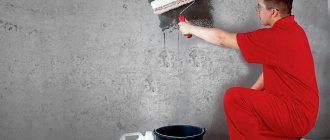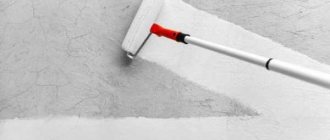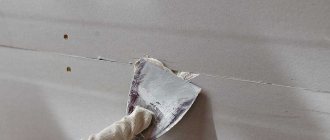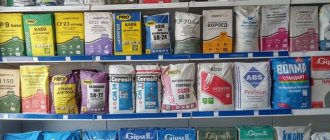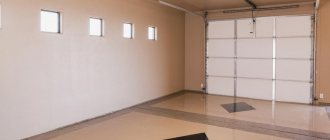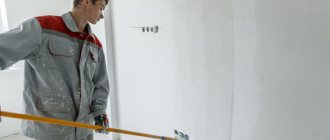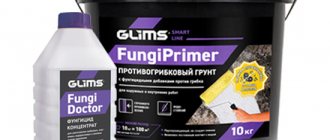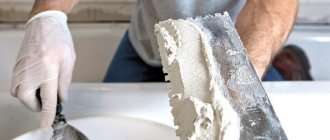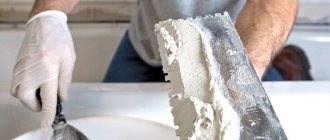What is a primer
This is a building composition in the form of a liquid, which is used to treat walls, floors, and ceilings. Performs the following tasks:
- enhances adhesion - the adhesion of dissimilar materials, in this case between
- processed surface and finishing;
- strengthens the foundation;
- levels the layer;
- protects against corrosion;
- saves paint consumption.
The composition of the mixture depends on its intended purpose and the type of surface. It applies to:
- concrete;
- brick;
- tree;
- drywall;
- old paint.
The primer composition must be kept in a well-closed container in a cool, dark room.
Primer for various surfaces
If we talk about universal primer solutions, then they can be safely used for wood, metal, concrete and even drywall. Aclide primer mixtures are suitable for treating metal surfaces. Griftal and epoxy primers also fall into this category. The latter type can also be used for concrete.
To be completely confident in your choice of primer, we advise you to carefully read the manufacturer's recommendations, which can be found on the product label.
The meaning of priming
Man began priming surfaces at the beginning of his historical journey. Artists were the first to do this - without a special primer it is impossible to put paint on canvas. The primed surface not only held the paint firmly, but also allowed the master to work comfortably - the base of the painting became dense and uniform in roughness. The same functions are inherent in modern primers. Padding:
- saturates the wall surface with moisture before applying plaster, which prevents it from taking water from the solution;
- creates a film with deep penetration into the wall (up to 1 cm), which significantly improves adhesion between its surface and the plaster;
- removes dust, including in places inaccessible to a brush or vacuum cleaner;
- muffles color spots on the wall (but not a transparent primer), turning its surface into a more monochromatic one, which is very important when wallpapering concrete;
- creates a smooth, easy-to-finish surface.
Before plastering
When redecorating an apartment or house, you should not miss one important nuance: the walls must be treated with a primer before plastering.
And let some experts prove that previous generations did not prime, and the plaster lasted for decades. One cannot agree with them for one reason: in the past, walls were reinforced with plaster mesh (metal), which rusted, and traces of rust very often made their way through the decorative coating of the walls.
Today, even concrete can be plastered without reinforcement thanks to a properly selected primer. Priming walls allows you to:
- Saturate the walls with moisture, as a result of which the chemical reactions of hydration of cement or gypsum are not interrupted due to lack of water (as is known, a number of wall materials - concrete, aerated concrete, brick, etc. - have the property of capillary suction of water molecules from the solution);
- Increase the strength of the wall surface while simultaneously creating good adhesion with the plaster solution. Deep penetration primers are absorbed into the wall material up to 1 cm, leaving a continuous film on the surface. When applying plaster, the film adheres to particles of cement or gypsum, providing a strong connection between the wall and the plaster;
- Bind dust, which actively counteracts any connecting processes;
- Achieve savings in the family budget. A wall treated with a primer has a smoother surface and good adhesion, which allows layers of plaster to be applied evenly. Therefore, it will be required less when compared with the consumption of a wall not treated with primer.
When plastering concrete, you need to be very careful when choosing a primer. They have their own primers on sale here. So, under gypsum solutions you need to use only a “concrete contact” primer, which binds dust, saturates the wall with moisture, and forms a film with high adhesive properties (due to the presence of quartz sand).
For information: a primer with “concrete contact” properties can also be used when laying plasterboard with ceramic tiles; during plastering work on polystyrene foam; when leveling walls with plasterboard using gypsum-based glue.
It is not recommended to use “concrete contact” under cement mortars.
Do I need to prime the walls before plastering?
Priming walls in construction means treating them with a special compound. This is done before applying leveling plaster, as well as between its layers and before decorative finishing.
Priming is not at all an insignificant stage in the work that can be skipped. It is needed for:
- Reinforcement of loose plasters, such as lime plasters. Strengthening impregnation penetrates deeply into such material and makes it stronger.
- Dust removal. As a rule, there is dust and small particles on the wall that impair adhesion to the finish. The primer glues all the dust on the surface, reducing the likelihood of the plaster peeling off in the future.
- Improving the adhesion of plaster and smooth surfaces such as concrete, plasterboard, etc.
- Increased water resistance. The primer closes the pores, prevents the base from absorbing water from the plaster solution, and allows the plaster to dry evenly.
- Prevention of mold due to the antiseptic in the composition.
- Saving material. On primed walls, the material takes longer to set, prolonging the time you work with it. There is less unused solution left.
Expert opinion
Sergei Shablovsky
Plasterer
Thus, before plastering, it is always necessary to prime porous substrates to reduce water absorption, and smooth surfaces to increase adhesion. To the question “is a primer necessary or not before plastering?”, I say - it’s definitely necessary!
What types of primers are there?
Types of wall primers are specifically designed for treating vertical surfaces, interior and exterior. They can be different in characteristics, method of application, basis, level of protection from negative factors.
Acrylic
It is a mixture of acrylic and latex. It increases the fixation of finishing materials on the surface. Widely used by professionals and beginners to perform construction and repair work. Varieties of acrylic primers have appeared that are in great demand - impregnating, penetrating deep into the layer, special, universal and others. Each drug has its own spectrum of action - enhancing the adhesion of materials, penetrating into the thickness of the surface, provided that non-standard materials are used in the work. It is used for surfaces with a reduced absorption coefficient of liquids.
Deep penetration before plaster
The first class of primers is a deep penetration primer.
Visually reminiscent of milk with a weak neutral odor. After application and drying, it leaves a durable film on the surface, thereby strengthening and removing dust from the layer.
A deep penetration primer is suitable for treating loose surfaces, which allows you to strengthen the wall and reduce paint consumption.
It works best to create a reliable base for heavy types of wallpaper.
Mineral
A primer based on mineral components is used for the initial treatment of surfaces for the purpose of leveling.
A primer based on mineral components works with surfaces made of specialized mineral materials: concrete, brick, plaster, as well as gas silicate and expanded clay concrete blocks.
Cement is used as a binder in such cases.
Adhesive mixtures
The use of such a primer will help improve the adhesion of the finish and the base. It is advisable to use adhesive primers when working with plastic, steel, tiles, and glass.
Antifungal primer
Types of primers differ from each other in the way they act on the surface. The primer is a liquid mixture that is applied to the required base - wall, floor, etc. - in order to improve adhesion to finishing materials (wallpaper, paint, putty). A finish without primer will last much less time. It strengthens old and loosely structured surfaces. Some modern paints will not adhere to the base without first applying a primer.
Fungus and mold have caused significant inconvenience to humanity for many years. Antifungal primer will become your faithful assistant in the fight against them. To avoid undesirable consequences, if you find mold on the wall, stock up on antifungal primer. It has proven itself to be an excellent means of prevention, used during the finishing of a room - in cases where fungus appears in the layers of thermal insulation. It is produced on an acrylic, mineral or alkyd base. The main component of the primer, the fungicide, prevents harmful microorganisms from forming in the treated surfaces. Among such primers there are also products with concentrated substances. They will help remove fungus, mold, and lichens from concrete or brick surfaces. Before applying any of the primers, dry and clean the required surface. Mold can be washed off with a cleaning agent or warm water. It is recommended to use a blowtorch or a hair dryer when cleaning. The primer is applied with a roller, natural bristle brush or airbrush. Wear protective clothing and a respirator for work, and gloves on your hands.
Isolating for color matching
This substance makes it possible to even out the colors of the final paint. In addition, during operation it will allow you to maintain the brightness and saturation of the applied color longer. It is used for both internal and external surfaces subject to painting or plastering.
Universal for plastering and painting
A universal, deep-penetrating primer designed for indoor and outdoor use and in areas where strong adhesion is expected. A universal option is used for walls before painting or plastering, as well as wallpapering. Additionally, it can be used for treating facades and floors.
Which primer is best for walls under plaster, which do professionals choose?
For most mortar manufacturers, the composition of primers is not very different, but the quality of the work done varies. This occurs due to the fact that the correct ratio of primer components is not always used during the manufacturing process and the quality of the raw materials does not always meet the standards.
In order not to make a mistake when choosing a primer, you can listen to the opinions of professionals.
Brick
Primer of brick walls before plastering can be done with the following mortars:
- Flagman;
- Knauf Grundiermittel;
- MAV AK-027.
If the brick wall is old, then you should choose a deep penetration primer.
How can concrete walls be primed (treated) before plastering and is it necessary to do so?
Concrete is a durable material with a porous structure. Pores are formed as a result of the evaporation of moisture, which did not take part in the hydration of the cement mortar. Water and other substances that come into contact with the surface enter these microholes. To minimize the negative impact of external environmental factors, you need to prime the wall.
Interior finishing should also be done using a primer. The primer will prevent mold from appearing. It will not allow the liquid components of the putty to be quickly absorbed, thanks to this the construction mixture will not lose its plasticity and will fit well on the work surface.
When choosing what to prime a concrete wall with before plastering, you should consider what material will be used to finish the surfaces. It is better not to buy concrete contact under gypsum plaster. Due to the sand contained in the composition, burrs will remain on the wall. For gypsum, a water-dispersion acrylic primer with deep penetration “Ceresit ST-17” is well suited.
Tree
For woodworking, preference should be given to compositions that have an oil, acrylic or mineral base. The primer should penetrate well into the fibers and protect the material from fungal attack. For exterior finishing work, you can choose polystyrene compounds. If the wood will be varnished in the future, then the impregnation should be colorless.
You can choose from the following products:
- Belinka Base;
- Tikkurila Valtti Expert;
- Pinotex Wood Primer.
Fibreboard, chipboard, plasterboard and OSB
Fiberboard, chipboard and OSB boards contain adhesive resins. To protect against the toxic effects of resins and prevent the destruction of building materials from external factors, the surface is primed.
Before treating OSB with a primer, it is necessary to remove the factory paraffin coating from the surface of the sheet. Drywall absorbs moisture well, so to process it, it will be enough to roll it over the wall once.
When working with fiberboard, chipboard, OSB and plasterboard, professionals recommend choosing adhesive, universal and reinforcing agents.
Foam block and aerated concrete
The surface of aerated concrete and foam block is porous. This increases the risk of destruction. Microorganisms can appear and develop in the pores. Their presence on interior walls can have a negative impact on health. Based on the possible risks when choosing a primer for gypsum plaster, you should opt for compounds that reduce the degree of moisture absorption and have strengthening and antiseptic properties.
Metal surfaces
When working on a metal surface, acrylic primers should not be used. Their use will promote the development of corrosion. To protect the metal, before plastering it must be degreased and then treated with an anti-corrosion agent. It is necessary to completely coat the entire wall so that there are no untreated areas left.
To increase adhesion, concrete contact is applied after the anti-corrosion composition has dried.
Additional adhesion of the plaster to the surface can be achieved using a reinforcing mesh, which is also treated with a primer. To work with a metal surface, you can use primer GF-019.
Insulation materials
If there is insulation on the wall on which putty will be applied, then it must also be protected with a primer. The Ceresit ST17 mortar is well suited for processing mineral wool. It is recommended to apply adhesive compounds with deep penetration to foam plastic and penoplex.
Selection parameters depending on surface type
An important factor when choosing can also be the type of surface itself on which the primer will be applied.
Concrete
Concrete contact or primer for concrete is designed to ensure sufficient adhesion to concrete. This is important for the subsequent application of putty or plaster on concrete and other surfaces that do not absorb moisture.
Tree
A primer for wood is also necessary, since it often acts as an antiseptic, which allows you to protect the wood from all sorts of destructive influences. This is most relevant for wooden surfaces located outdoors.
Gypsum
Gypsum putty or gypsum coating is a surface characterized by increased absorbency, which requires the use of a specialized primer.
Brick
There is an opinion that it is possible to apply plaster or paint to a brick wall without prior priming, since high-quality adhesion will be ensured. However, it is recommended to prime the brick base, since not all building mixtures include primer additives, which can lead to accelerated cracking and destruction of the entire layer.
What and how to prime aerated concrete before plastering
The choice of primer for aerated concrete is determined taking into account the climatic and temperature conditions of use. Internal and external emulsions must have increased water-repellent properties and resist moisture. The presence of antiseptic additives that provide the block with antibacterial protection and the ability to resist on the walls is required when working on both sides. A high vapor permeability rate is important for external, but not for internal surfaces.
The highest priority for the latter are compositions that can penetrate as deeply as possible into aerated concrete. The disadvantage of emulsions is increased material consumption. It is allowed to apply universal primers that can solve all the listed problems. Note that such compositions are low in cost.
It is most convenient to prime the walls in one of two ways:
- Compressor.
- Roller or brush.
How to calculate primer consumption
The required amount of primer depends on many indicators - the concentration of the solution, the type of primer, the type of surface being treated, as well as its ability to absorb liquid. For example, the consumption of a deep penetration primer mixture is 1 kg per 5-7, and a strengthening mixture is 1 kg per 5-15.
In order to calculate the amount of soil to treat the surface, you need to measure the area of the walls being treated and multiply this figure by the material consumption rate provided on the label. Usually the surface needs to be primed 2-3 times, so this figure needs to be multiplied by the number of layers.
It is also necessary to check how the wall absorbs moisture; to do this, you need to spray water on it from a spray bottle; if it is immediately absorbed, then the degree of absorption is very high, and 1.5-2 times more primer will be required than normal, and if it immediately drains, then very low and less soil will be required.
Price of finished work
Very rarely, priming of walls is carried out separately from other finishing work; usually the package of services also includes plaster or putty. The cost of finished priming work includes the cost of material: the average price of strengthening soils for 10 liters is 300–500 rubles, and deep soils are 500–700 rubles per 10 liters, as well as the work itself. The price of services for priming walls from repairmen ranges from 50-100 rubles per hour.
Correct selection and use of primers for bricks
Brickwork walls are used both in new construction and are also found when performing renovations. The most common way to finish a brick wall is to plaster it and then apply finishing materials. But there are cases when the wall just needs to be painted. Change the color of the brickwork. In such moments, you cannot do without primers. Primer mixtures will help to perform high-quality finishing work on a brick wall.
How to choose soil for a brick wall
Before choosing soil you must:
- pay attention to the condition of the brick wall;
- determine the type of brick (facing, ordinary);
- find out the material from which the brick is made (clay, silicate, hyper-pressed, aerated concrete);
- find out the finishing material that will go on the wall.
All these factors will help determine the type of primer mixture. It is also worth considering future operating parameters. Will it be a dry or wet room. Where will the primer be applied: outside or inside the building.
Preparation for application
The primer goes on sale in a dry and ready-to-use state, which can be applied immediately. They also sell concentrated solutions, which are brought to readiness by diluting with water.
A ready-to-use product (for example, an acrylic primer) is stirred so that all components are correctly distributed throughout the composition, and then the required amount is poured into a container and processed.
Water-dispersed soil concentrate is diluted in a ratio of 1:4 (add 4 parts of water to one part of concentrate). The required amount of concentrate is poured into a clean container, and then water is added - thus obtaining the necessary portion of soil to treat a certain surface area.
The two-component primer is diluted in the following sequence: first, the hardener is introduced, and then the thinner is added to obtain the desired viscosity.
Dry soil is diluted with water in a ratio of 1:4. Alkyd primer compositions are diluted with solvent 649, 650, xylene, solvent (the proportions are indicated on the packaging). Oily soils are diluted with drying oil.
It is important to remember that the instructions for diluting the composition are consistent with the requirements of GOST; deviation from the proportions may lead to a violation of the work technology, and the base will not acquire the necessary qualities.
General application technology
Priming the surface before finishing is an indispensable condition for successful repairs; this procedure cannot be skipped. Before you start working, you need to prepare the following tools: brushes, a roller with a telescopic extension, a primer tray. A stepladder will not hurt - it is convenient to work on the walls in the upper part and the ceiling.
Next, prepare the surface: wash off the whitewash, remove old wallpaper, clean it of dust, dirt, and oil stains. After reading the instructions for diluting the primer, prepare it and, after pouring a small amount into a tray, begin priming. You can work with soil at temperatures from 5 to 30 degrees and air humidity up to 75%.
The surface is coated thoroughly, leaving no gaps and no smudges. In places that cannot be reached with a roller, they work with brushes. After treatment, the surface must dry (the drying time of the primer is indicated on the packaging). If necessary, apply a second coat of primer.
Plastering with plaster
You can plaster a brick wall with gypsum mortar. Gypsum mortar is attached to the wall mechanically, unlike cement-sand mortar, which requires waiting for the result of a chemical reaction to fasten it. Gypsum mortar should not be used in damp rooms or where wall vibration occurs. As a rule, it is used for finishing plaster walls.
Gypsum is applied to the wall by spraying, then it is quickly leveled. The gypsum solution sets quickly, so prepare it in small portions. To properly prepare a gypsum solution, carefully read the instructions provided by the manufacturer. After applying gypsum plaster, the wall surface without defects is ready for any further finishing.
Primer Application Methods
The primer is applied to the surface to be treated in different ways: manually (brush, roller) or using automated means (spray gun, spray gun). The choice of method depends on the scope of work. If we are talking about processing one or two walls, it is better to prime with a roller. When you have to do a lot of priming, you can’t do without a spray gun. On the primer package, the manufacturer indicates acceptable methods of use. The user himself chooses a method of surface treatment that is convenient and accessible to him.
How to apply with a brush
Brushes for applying primers are used in cases where it is necessary to treat minor areas of the surface. The tool is not effective over large areas. As a rule, brushes are used to prime areas that are difficult to reach with a roller or sprayer.
The technology of applying primer to the surface is no different from the same work with paint. The brush is dipped into the soil, then pressed against the walls of the container to drain off excess material. On the surface, use a brush to fill the space, without smudges or gaps. You need to work carefully so that the primer does not drip onto the floor, splash on other walls, windows, clothes, or get on open areas of your hands or eyes.
If the material gets into your eyes, immediately wash them with plenty of water. If during work the soil gets on the window glass, then the drops are also immediately removed with a damp cloth, otherwise, after drying, difficult-to-remove stains will remain on the glass. Applying primer over large areas with a brush is labor-intensive and time-consuming work. It is better to do it with a roller.
How to apply with a roller
Working with a roller is much faster than using a brush. The tool covers a large area in one pass and applies the primer evenly to the surface. Roller processing has its own characteristics.
To work, you need a special tray into which primer is poured in portions. The roller is dipped into the liquid and rolled on the ribbed part of the tray so that the excess material drains off and the roller itself is evenly saturated. Then they transfer the tool to the surface and roll a section of it, trying to apply the primer evenly. At the same time, omissions and smudges are not allowed.
The next batch of soil begins to be applied next to the previous one, gradually entering the previously treated area. To avoid any gaps, add a little color to the primer that is close in color to the main color of the finish. This way you can control the priming process and avoid omissions.
To reach the ceiling and upper parts of the wall with the roller, a telescopic extension is attached to the tool. In places where it is impossible to reach with a roller, cover the base with a brush.
When working with the tool, make sure that the primer does not drip onto the floor, clothes, body, or get into your eyes. Gloves and goggles are used to protect the body and eyes. The floor is covered with plastic film, paper, cardboard.
How to apply by spray
The most effective way to prime large areas is to spray with a spray gun. The primer is prepared in the usual way described above. The main thing is to choose a nozzle that matches the grain size, viscosity and fluidity of the material. To apply primer, use nozzles from 1.4 to 1.8 mm and a needle along the diameter of the nozzle.
The next step is to adjust the shape of the torch (with a special screw) and the volume of applied primer on the sprayer. Set the supply air pressure within 3–5 bar. Apply the composition to the probe and evaluate the quality of the spray. The prepared primer is poured into a paint sprayer and, taking precautions, the material is applied to the base. They work quickly with the spray gun, apply the primer evenly, and do not stay in one place for long, otherwise there will be smudges. After coating, wait for the soil to dry and begin further processing.
Features of plastering concrete walls with your own hands, instructions and advice from experts
Some home craftsmen are afraid of plastering work, this is due to the fact that it is labor-intensive and requires certain qualifications. Hiring specialists is expensive , so if you have the desire, you can handle this work yourself.
Advantages and disadvantages
Many houses and apartments have concrete walls, and when the question arises about what material to decorate them with, plaster is often chosen.
Such walls have good performance characteristics , but due to the fact that they are very dense and hard, their finishing technology has certain features.
Bare concrete walls can be immediately wallpapered or painted, but the walls are not always in perfect condition ; they usually need to be plastered.
Some craftsmen solve this issue by using drywall.
This option has a number of disadvantages: firstly, drywall cannot withstand heavy loads, and secondly, the creation of lathing takes up part of the free space of the room. Features of finishing a concrete wall with plaster are as follows:
- since concrete is nasty and dense, the solution does not stick well to it;
- remember that plaster on a concrete wall will take longer to dry than on a brick surface;
- Before plastering concrete walls, they must be specially prepared: make notches, apply a primer, secure the reinforcing mesh;
- if you need to cut an opening in a concrete wall, you need to do this before plastering, in order to save mortar.
How long can it take to plaster?
It all depends on what kind of primer you used.
Thus, acrylic primer dries in 8 hours, while oil, glyphthalic or contact primer takes a much longer time to dry, about 24 hours. Mineral soil dries in different ways, it all depends on the thickness of the applied layer - from 3 hours to a day. Phenolic soil takes approximately 15 hours to dry. Quick-drying primers are also sold; after treating them, walls can be plastered in 6-7 hours. Alkyd primer dries in 10-12 hours. And perchlorovinyl primer, when applied in 1 layer in summer in hot weather, dries in 60 minutes.
Polyvinyl acetate primer dries in half an hour.
You can treat the walls with a primer yourself. It’s better not to be lazy and spend a little extra time so as not to be disappointed with the result. Moreover, applying a primer is not so difficult; minimal skills in working with a brush or paint roller are enough, although for large-scale work it is better to use a professional spray gun.
Why do you need a primer for walls?
Practice shows that the final result of wall finishing depends 80% on the correctly selected primer material. If the mixture is chosen incorrectly, or the surface coating is applied to an unprimed wall, there is a high probability that the applied plaster will soon fall off or crack, the paint will peel off, the wood will begin to rot, and a layer of rust will appear on the metal. So, why do you need primer treatment?
- Improves adhesion . The key function of the primer is to create reliable adhesion between the main surface and the finishing material. Thanks to the primer, the paint or putty lasts for years.
- Strengthens the work surface. Some walls have a weak surface, which means they crack and collapse. The primer penetrates deep into the surface, holds it together and creates reliable support for the exterior finish.
- Antiseptic effect. Primer treatment protects walls, especially wooden or damp concrete ones, from the appearance of fungus and mold.
- Corrosion protection. Applying primer mixtures to a metal wall protects the metal from corrosion.
- Saves finishing materials. Applying paint, varnish or liquid glass to a primed surface allows you to save up to 40% of materials due to the fact that they are not absorbed.
- Moisture protection. The destruction of materials begins with the penetration of moisture, and the primer becomes a reliable protection against its penetration.
- Durability. The finishing material applied to the primed surface lasts for many years without peeling or falling off.
- Easy removal of the layer during the next repair. Having treated the wall with a primer, during subsequent repairs it will be much easier to remove the previous layer.
Making your own primer
There are 3 recipes for preparing primers. All of them are easy to make with your own hands.
To improve adhesion
It can be applied to any glossy surface, for example, metal pipes, sheets of tin.
- Bring 1 liter of water to a boil in an enamel bowl, place 250 g of potassium alum.
- Pour 200 g of dry paint glue into a separate bowl and pour in 2 liters of water.
- Place the dish with glue on the stove, light the burner, add a grated piece of laundry soap (70%), mix thoroughly.
- Grind 2 kg of chalk to a dust state.
- After dissolving the soap, pour in 30 ml of drying oil and 2 kg of chalk powder and mix.
- If the primer is too thick, add water.
To increase strength
- Pour 7 liters of water into an enamel bucket or pan, place it on the stove, light the fire and wait for the water to boil.
- Rub 1 piece of laundry soap (65%) on a grater.
- Pour soap into boiling water and turn the heat to low. Continuously stir the mixture with a wooden spoon.
- After the soap has completely dissolved, pour in 500 ml of wood glue and add 100 g of copper sulfate.
- Mix the mixture thoroughly for half an hour. It is impossible for lumps to appear.
- Then strain the hot mixture through a sieve and cool.
This primer can be applied to walls made of concrete and brick.
Deep penetration
- Pour 1 liter of PVA glue into an enamel bowl, gradually add 8 liters of water, stirring until the mixture becomes homogeneous.
- Add 1 trowel of cement and mix thoroughly.
- Strain through gauze folded in 2 layers and prime the walls.
- The prepared mixture is immediately applied to the walls.
Benefits of priming walls
The best explanation of the benefits and importance of priming walls will be a list of the main advantages and disadvantages of prepared surfaces:
- Strengthening the surface layer of the surface to be plastered. The use of a primer is especially important for loose and porous walls, which are characterized by increased absorbency of the material. After treating weak and fragile bases with a deep penetration primer, the structure is strengthened to a depth of 8 to 10 cm, which greatly increases the strength of the plaster layer.
- Binding of dust particles remaining after cleaning the surface from dirt and dust accumulations. If you run your palm over the wall before and after applying the primer, you can visually notice a big difference between the number of dust particles remaining on the surface of your hand.
- Improving adhesion (adhesion) of the base surface with the finishing solution. This is the main functional purpose of the primer: microdefects are removed, small cracks and irregularities are filled.
- After treatment with a primer, a thin polymerized film of microscopic size is formed on the surface, which allows reducing the consumption of the plaster mixture to approximately 30%. After applying the primer, the layer of plaster mixture is evenly distributed and an increase in the strength of the finish is observed.
- With the help of special biological components, a reliable protective coating is created on the surface against fungal diseases, rust stains and mold.
Some surfaces may be moistened with water before plastering. However, in practice, the best result in surface preparation is obtained by priming the walls, since in this case any finishing material is consumed more economically and is more firmly fixed to the surface
Properly selected and applied primer has a positive effect on the quality of the plaster and the final decorative coating.
The best primers from the store
1. Acrylic - it is applied to wooden, concrete, brick, plastered walls, and chipboard.
It has no odor; after applying it to the walls, they “breathe.” It is not suitable for smooth surfaces. 2. Alkyd - it is used to treat wood surfaces, which then swell somewhat, so wallpaper sticks well to them. It may contain mixtures that prevent corrosion and mold from appearing.
3. Glyphthalic - suitable for metal. But it is only suitable for dry rooms.
4. Perchlorovinyl - it is universal, suitable for wooden, brick, plastered and metal walls. It is toxic, which is why only outdoor walls are treated with it.
5. Polyvinyl acetate, it includes polyvinyl acetate dispersion and latex. It can be used to cover any surface, but only polyvinyl acetate paint can be applied to it.
6. Phenolic - it is applied as the first layer on walls made of metal and wood. But since it is poisonous, it can only be applied to external structures.
7. Polystyrene - it is also used to cover external walls; it cannot be used indoors. It is applied to plaster and wooden walls.
8. Aluminum, it is used to treat wood surfaces and protects them from fungus.
9. Epoxy is applied to concrete surfaces for better adhesion and to protect the metal from corrosion.
10. Shellac is used to treat wooden walls to prevent resins from escaping from them.
11. Mineral is made of cement, gypsum, lime. It is covered with concrete and brick.
12. Universal.
Types of primers
There are several types of soil for aerated concrete blocks. They are selected individually, as they have multiple differences.
| Base | Types of primer |
| By composition |
|
| By degree of penetration |
|
| By purpose |
|
| By place of use |
|
| By properties |
|
Expert opinion Vitaly Kudryashov builder, aspiring author
Ask a Question
Note! Some types of primer (fireproof, filler, alkyd) indicated in the table are given as informational material. Not applicable to aerated concrete walls.
With hydrophobic additives
The film-forming composition has the property of sharply reducing the water-absorbing qualities of the aerated block. Thanks to the formation of a thin protective film, it prevents the penetration of moisture from the atmosphere as a result of precipitation, including slanting rain. Increases vapor permeability to the outside rather than inside the building. Has adhesive (cohesive) properties.
Standard
The emulsion has a narrow focus. Its application to the gas block helps improve the adhesive properties of the surface and the plaster mixture. The remaining parameters: vapor permeability, hydrophobicity, strength -0 remain unchanged.
Polymer
A special composition including additives of liquid polymers. Characterized by increased fluidity. After drying, it forms a durable, water-repellent film on the surface of the walls.
Strengthening soils
They have a deep penetrating effect. Used for processing loose, porous surfaces. Ideal for application to gas and foam blocks. The composition contains many adhesive components. They provide high-quality adhesion between the wall and the plaster not only on the surface, but also deep inside, forming one whole.
Universal
The universal primer for gas blocks has a wide range of inherent properties. Can be used indoors and outdoors. Mostly it has a minimum set of active components. It is used only in cases where there is no urgent need to prime the walls. For example, before wallpapering.
Silicate
The manufacturer recommends using compositions based on potassium liquid glass for treating walls made of sand-lime brick, concrete and bark beetle plaster with subsequent painting. In practice, primer is used in the finishing of industrial and other non-residential facilities. Regarding aerated concrete, he does not voice any restrictions. Additionally, based on the fluid characteristics, the materials appear to be compatible. Silicate primer (vapor-permeable, water-repellent) does not support the development of microorganisms.
Pros and cons of using primer
So why do you need wall primer? To answer this question, you need to understand what advantages and disadvantages this procedure has.
The benefits of using a primer include:
- Walls treated with primer are well protected from damage that may occur, for example, when removing old wallpaper.
- The primer layer increases the moisture resistance of the walls, reliably protects the treated surface from destructive processes, the appearance of dampness, mold, and mildew.
- The antiseptic components included in the composition have a specific odor that repels harmful insects and microbes.
- The final layers applied over the primer will be more resistant to various influences and will last longer.
Answers to frequently asked questions
Few doubt the importance of applying primer mixtures. But still, when carrying out repair work, especially when doing it yourself, a number of questions often arise.
Is it possible to apply plaster without a primer?
To answer this question, you need to understand what type of surface needs to be plastered and what composition of the plaster mixture will be used. If you plan to plaster brick walls with cement-sand or lime mortars, it is enough to moisten the surface generously with water and, without waiting for complete drying, begin applying the plaster mixture on the wet base.
Previously, before plastering smooth concrete surfaces, it was necessary to make notches into the concrete or cinder block with an ax or similar sharp object. It was a labor-intensive and lengthy procedure, and also completely unsafe. Concrete shards could damage your eyes, hands, and could easily result in minor injury. Therefore, we had to work with great caution. Currently, this entire labor-intensive process is replaced by an adhesive primer such as “Betonokontakt”, which perfectly prepares concrete for the application of gypsum or cement plaster.
Recommendations
When priming walls, you can use the following recommendations:
- The primer product is best purchased in prepackaged plastic containers. Manufacturers produce primer in convenient containers from 1 to 10 liters. By calculating the standard primer consumption, you can purchase the required amount of primer and not make extra supplies.
- You can often hear advice that the primer can be successfully replaced with water-based paint. A full replacement will not work, since the paint contains few special additives that promote better adhesion of the base and the plaster layer. The film coating turns out to be weak and will strongly “pull” moisture from the solution. Due to uneven drying of the applied mixture, deep shrinkage cracks will appear as the plaster layer dries, which will subsequently lead to irreversible deformation damage to the entire plaster coating.
- Guaranteeing the quality of the plaster is achieved under the conditions of the correct choice of primer, depending on the type of base and the intended composition of the plaster mixture.
Priming the walls is an indispensable stage of repair work. Surfaces treated with primer will be able to retain the finishing solution for a long time, which significantly increases the service life of the final decorative finish.
Common Mistakes
Even though the task is not too difficult, common mistakes are common. The first of them is the use of dispersion and water-emulsion pigmented paint. It does not perform all the functions that are required. Also, you should not use it even as a second layer - this leads to the formation of various stains. The main mistake is applying one layer, because almost always two are required.
Not everyone knows whether it is necessary to prime a wall before plastering, so they do not do this work. This approach is also wrong.
Remember that priming the walls always precedes plastering. This is the only way the walls will be able to keep the coating for years. Treating the surface with a strengthening mixture is a common practice for many advanced builders.
Pros of primer
In addition, the application of primer is of great importance, since it produces:
- Disinfection of the coating, which does not allow mold to penetrate;
- A special film also appears that prevents moisture from seeping through;
- Improves adhesion (bond between dissimilar surfaces brought into contact);
- And etc.
All this provides good and cozy housing, the walls of which will protect from unnecessary dampness and will serve for a long time and with high quality.
Useful tips
Arm yourself with useful recommendations from professional craftsmen: this will help you achieve the highest quality results when carrying out finishing work. Plastered surfaces will be reliable and durable if the material is selected correctly:
- When purchasing, choose water-soluble formulations. They have a breathable texture and do not accumulate moisture.
- If the composition contains solvents, they are not suitable for processing foam.
- Before applying primer, it is important not only to clean the base, but also to wipe it with a damp cloth to remove dust. Otherwise it will be on the surface, which will affect the color of the base.
- The primer must be diluted in strict proportions. Do not compromise the consistency: this will affect the consumption and absorbency of the walls.
- The layer of application of the composition should not be dense. It is important to maintain uniformity over the entire surface being processed.
- The primer can only be applied to a dry base.
- The most difficult to reach places can be treated with a spray bottle.
- If the surface being treated consists of several materials of different composition, use a universal primer or separate compositions (if you have the finances).
- Wear protective glasses and gloves when working. If liquid gets on your skin, wash it immediately, otherwise it will be difficult to remove.
- If the soil has an odor, buy a respirator. Special clothing is recommended: if it gets on it, it will leave stains.
- When finished, wash your roller and brush immediately. If the primer dries out, you will have to change the roller coat and throw away the brush.
Sources
- https://otdelkasten.com/pokraska-sten/kak-nanosit-na-steny-gruntovku
- https://StroyGuru.com/remont-kvartiry/steny/zachem-nuzhna-gruntovka-sten/
- https://otdelkasten.com/pokraska-sten/luchshaja-gruntovka-dlja-sten
- https://stenamaster.ru/vidy-gruntovok-ih-primenenie-261.html
- https://mastremont.ru/kakoj-gruntovkoj-obrabotat-steny-pered-shtukaturkoj/
- https://cozzyroom.com/remont/gruntovka-sten.html
- https://odissey2000.ru/staty/kak-gruntovat-steny-instrukciya-po-pravilnomu-naneseniyu-gruntovki
- https://otdelkasten.com/shtukaturka-sten/gruntovka-sten-pered-shtukaturkoj
- https://diy.obi.ru/articles/gryntovka-dlya-sten-pravila-vibora-i-ispolzovaniya-20910/
- https://GidPoKraske.ru/gruntovanie/gruntovochnye-raboty/gruntovka-sten-pered-shtukaturkoj.html
- https://dekoriko.ru/gruntovka/pered-shtukaturkoj/
Features of the work
Before starting plastering, it is necessary to determine the unevenness of the wall in order to hide these defects during plastering.
The surface intended for plastering work must be dry, clean, strong and provide bond strength.
The choice of primer is influenced by the degree of porosity of the brick and its ability to absorb moisture. If the brick is dense and smooth, then it is better to use a primer with improved adhesive properties.
A universal primer is applied to bricks of medium porosity; it can be determined experimentally. Drop water onto the brick. If a drop of water dries on its surface for 3-20 minutes, then it is of medium porosity.
Brick walls are best treated with a mineral-based primer, in which cement is the binding element. Apply the primer in a layer of 0.2 mm.
On the prepared surface, hang a metal mesh with 10 mm holes on hooks located at a distance of 250 mm from each other. To protect the mesh from rust, it is coated with red lead or varnish.
In order to properly plaster a wall, it is necessary to properly prepare the solution and apply it to the work surface. To make it easier to evenly apply a layer of plaster on the wall, prepare beacons. Based on them, it is convenient to apply it to the work surface.
Prepare the solution from a sand-cement mixture, which you dilute with water and mix well until a homogeneous mass of the desired consistency is obtained. Apply beacon cakes to the wall every 500 mm, making them the same size. After they have dried, apply a base coat of plaster. It is applied above the beacons, this strengthens the adhesion of the entire layer of plaster.
Then you need to level the surface with a float; if this work results in depressions and unevenness, fill these places with a solution and rub the surface, not forgetting to spray it with water, after which it will become even and smooth. If you want to give the surface an even more uniform appearance, wipe it with a block wrapped in felt. To do this, apply another layer 4 mm thick and, when grouting, spray the surface with lime milk.
Strengthening the plaster with a mesh not only strengthens the plaster, but also helps prevent the wall from cracking during use.
Very often, plaster is strengthened with a mesh; it helps to avoid defects. Apply the solution to the wall in a layer not exceeding 25 mm, and it is best to apply several thin layers of plaster, before doing this, wait until each previous one has dried.
Plaster applied to a brick wall hardens and becomes strong and durable. When the drying process is accelerated, cracks often form, which lead to the destruction of the coating.
It is necessary to apply the next layer only after the bottom layer has completely dried, otherwise they both may come off the wall. Do not dry the plaster while the central heating system is running, this often leads to the appearance of numerous cracks. Drying requires fresh air; it contains carbon dioxide, which enhances the setting of the plaster. Without it, it does not harden.
If you are trying to plaster a wall for the first time, do it with a spatula, it will be much more convenient. You can remove excess solution by moving it from the bottom up.
